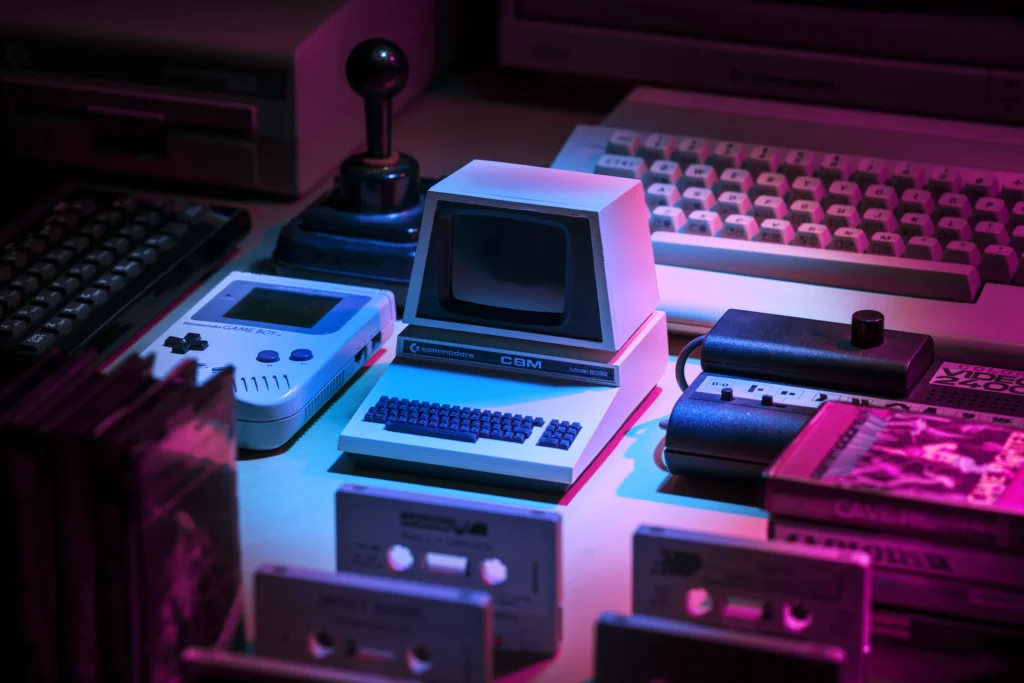Table of Contents
What are the best handheld consoles for retro gaming available today, how are we evaluating them, and which one is best for you? Let’s dive into it!
A Quick Disclaimer on “Retro”
First, I’m going to make a quick disclaimer about what devices will be covered in this article.
While I’ll primarily be discussing modern devices that are currently being sold by their manufacturers, I’ll also discuss a few devices that are…decently common on the secondhand market and still worth acquiring, if in good condition. If we’re covering “retro games”, then some “retro handhelds” are still definitely worth mentioning.
Even if a modern device with emulation can be “better” at playing some legacy titles, it doesn’t mean that using those legacy titles isn’t worth it. Beyond historical value, some devices (like the 3DS family) have features that simply can’t be duplicated by modern devices.
With that point settled, let’s get started!
Does Emulation Count?
Absolutely. If your device is capable of emulation, you can get quite a lot more value out of it as the end user. Plus, most backward compatibility solutions these days explicitly rely on emulation…sometimes a major game company will even use a fan emulator in an official release! A manufacturer like Nintendo can even build in-house emulators for emulating their past games, though…they aren’t as good at it yet as you might expect.
However, you should be mindful to only emulate games that you own and have legal personal backups of. There’s a lot more to the legality of emulation than I’m qualified to cover here, but the applications are legal. I’ve embedded a video from The Gaming Historian Below for those interested:
Do Smartphones Count?
Sort of, but not really as handheld consoles, I wouldn’t say.
The closest phones that come to mind for that are the infamous Nokia N-Gage and the niche Sony Xperia Play, aka the ‘PlayStation Phone’. I actually had one of these— it ran Android Gingerbread and it came with a nice slide-out gamepad styled similarly to the PSP Go. Unfortunately it couldn’t play PSP games, but it did emulate PS1 titles well thanks to a Sony-developed emulator on the device.
The Best Handheld Consoles For Retro Gaming
Class 1 — Gamers
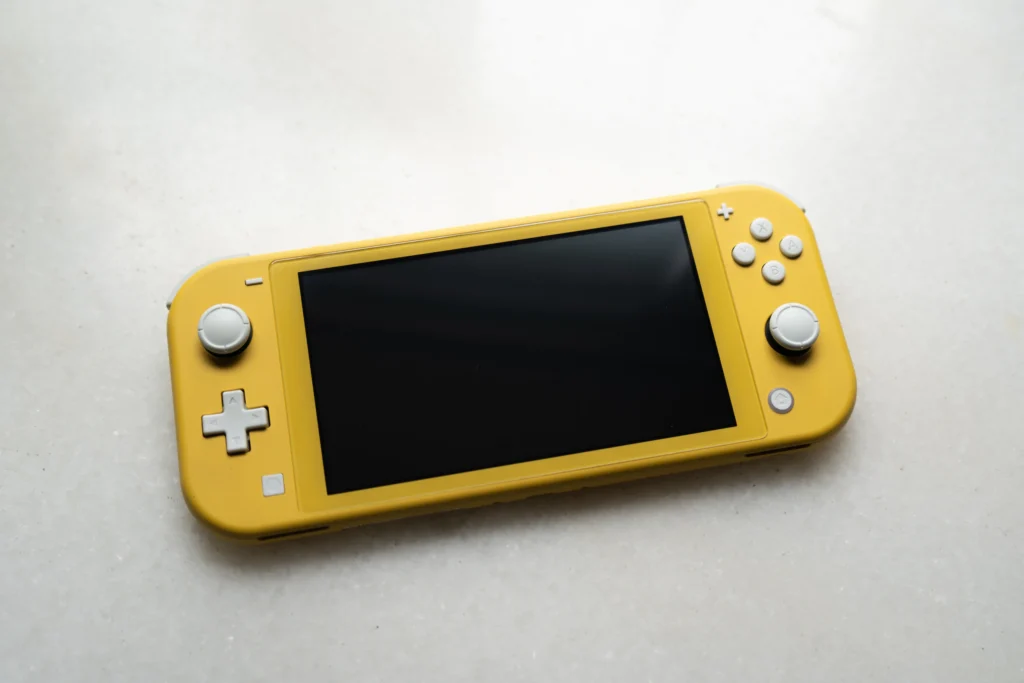
Nintendo Switch Lite
Core Specs & Info:
- Price: $199
- Screen Resolution: 1280 x 720
- Screen Type and Size: 5.5-Inch LCD
- Onboard Storage: 32 GB
- Past System Compatibility: Switch Online Membership (NES, SNES, Game Boy, N64*, Game Boy Advance*).
- Notes: *requires ‘Expansion Pack’ for additional fee
Pros:
- Cheap entry-level pricing.
- Compact screen size makes the 720p resolution look incredibly crisp.
- Switch Online service adds online multiplayer to many NES and SNES games that otherwise wouldn’t have it, and even includes a “pixel perfect” scaling option. Fairly good emulation,for the most part!
Cons:
- Switch Online fees for retro catalog access, no option to just buy retro titles outside of full Switch re-releases. Seeing as this used to be a feature on the Wii Virtual Console, it is a noticeable downside for many a humble preservationist.
- Pretty much impossible to emulate on this device without hard-modding the system.
- No docking-to-TV functionality, like on the full-size Nintendo Switch.
The Nintendo Switch Lite is my first recommendation, especially if you just want the most straightforward experience grabbing a cheap gaming handheld with modern releases. Nintendo has always dominated the handheld gaming market in sheer sales volume, and with the release of the Switch, they essentially consolidated their home and handheld console lines into a single entity.
The Switch is still priced a little more like a Nintendo console, but fortunately the Nintendo Switch Lite brings back that market-shaking price in full force. Whatever the Switch Lite could be lacking in theory compared to a similarly-priced tablet is easily offset by the sheer development time put into optimizing games on Switch.
The Lite is just a smaller Switch without docking functionality, and that compromise nets you a $200 handheld that’s pretty much just a modern entry-level game console. Games may get compromises coming to Switch, but they’ll look better on a Lite screen than in any other form, and the fact that Switch Lite even plays titles like Doom: Eternal at 30 FPS is a technical marvel.
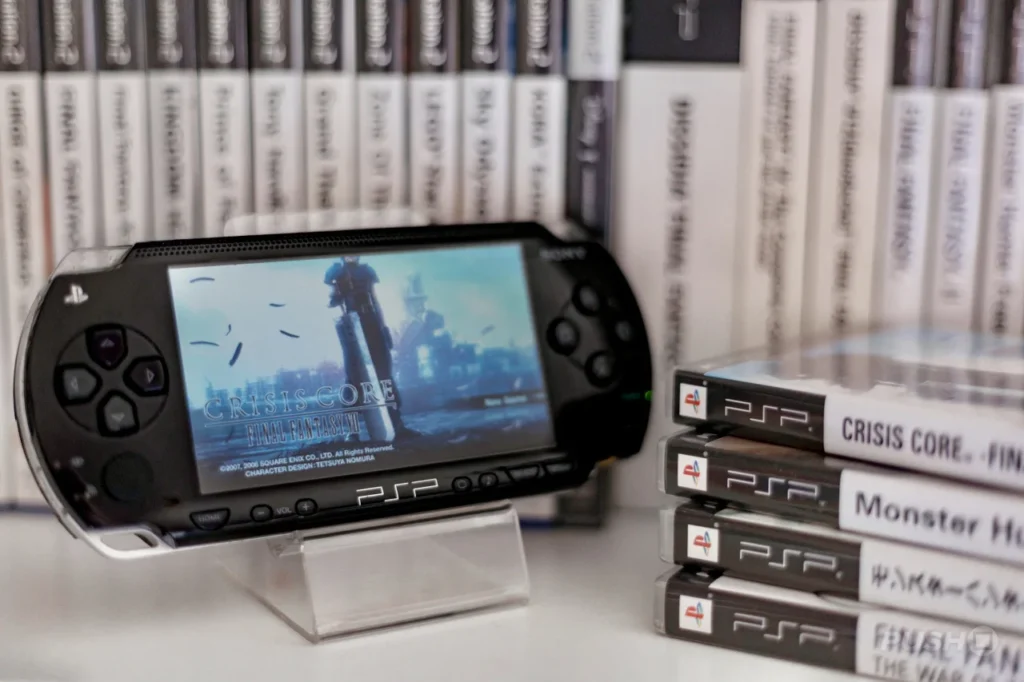
PlayStation Portable*
Core Specs & Info:
- Price: Depends On Used Market
- Screen Resolution: 480 x 272
- Screen Type and Size: 4.3-Inch LCD
- Onboard Storage: N/A, Proprietary (Expensive) Memory Sticks Needed
- Past System Compatibility: PlayStation 1 Games (Native or PS3 Remote Play), Emulation For Other Consoles Discussed Below
Pros:
- The most powerful handheld of its generation! Produced PlayStation 2-comparable graphics on a handheld in the era of the Nintendo DS, which still mostly produced games resembling N64 titles more than Nintendo’s then-current home systems..
- Native support for emulating PlayStation 1 titles! Considering how long it took other handhelds and smartphones to catch up with this feat (PSP released in ‘05!), I’m still impressed by it.
Cons:
- Official storefront has been shut down, but you can still acquire game downloads from PlayStation Store through a PlayStation 3 or PlayStation Vita. Still a considerable downside, though.
- Proprietary Memory Sticks are expensive! Especially for larger games like Metal Gear Solid: Peace Walker or Dissidia 012 released later in the system’s life cycle, which benefit in load times when installed to the Memory Stick.
- Remote Play with PS3 titles limited to PS1 emulation and oddly few actual PS3 titles, even though it seemingly worked fine with Lair.
The PlayStation Portable was Sony’s first entry into the portable gaming market, shortly following the release of the Nintendo DS and the official end of the Game Boy line of handheld consoles from Nintendo.
The PlayStation Portable was actually quite the standout device compared to the Nintendo DS in 2004, and included many features commonplace in today’s smartphones, including Wi-Fi web browsing support, MP3 and MP4 playback, and image storage. It launched with a slightly simpler version of the XMB UI that would later become more popularized by the PlayStation 3 upon its release in 2006.
Besides modern features and a stylish interface, the PSP also has the benefit of hardware power more comparable to that of a PlayStation 2 than anything else that had previously been seen in the handheld gaming market at the time of its release. Considering it came out before the PS3, it was essentially the Nintendo Switch of its time, albeit with quite a few compromises to controls (ie no dual analog) compared to a proper PS2.
The PSP is one of my favorite portables ever made, especially if you’re able to get a model with homebrew installed to play imported games and emulate non-Sony games. It has its compromises, especially if you don’t want to claw grip, but the quality of experiences on offer still make the PSP a worthwhile buy.
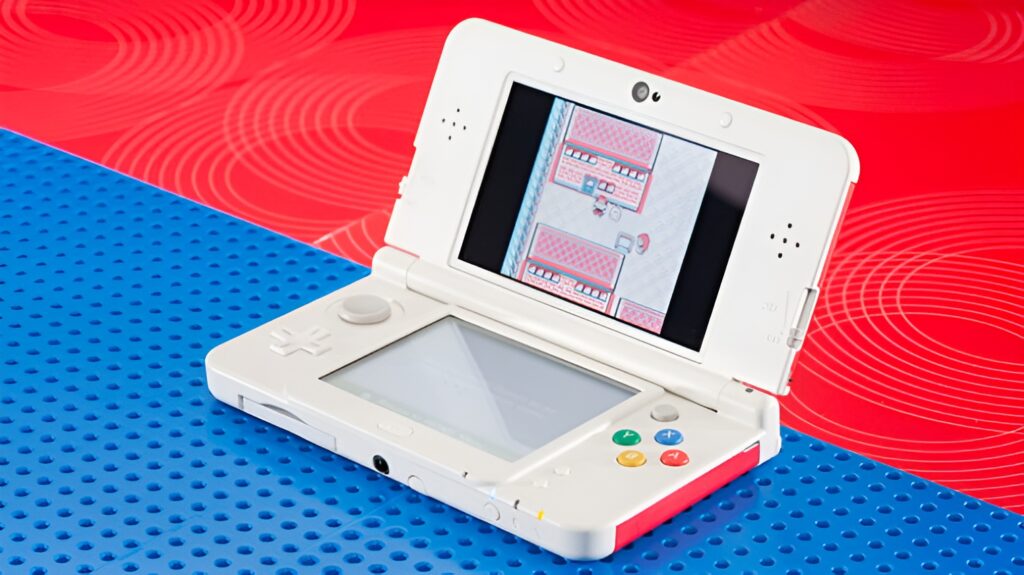
“New” Nintendo 3DS*
Core Specs & Info:
- Price: Depends on Used Market
- Screen Resolution: 400 x 240 (3D top screen) per eye, 320 x 240 (bottom screen)
- Screen Type and Size: Dual Screen IPS, Top screen is wider and 3.5 inches diagonal
- Onboard Storage: 1 GB Internal, 4 GB Included SD Card
- Past System Compatibility: Nintendo DS, Nintendo 3DS, SNES
Pros:
- The last dual-screen Nintendo handheld with glasses-free 3D support
- Genuinely one of the greatest combined libraries (NDS and original 3DS) even before games made for and/or utilizing the New 3DS’ hardware are taken into consideration
- New 3DS model offers access to higher hardware power and a second analog nub for compatibility with a few New 3DS exclusive titles (like Xenoblade 3D) and, if cracked, even more horsepower for homebrew software.
- XL model also available for a larger screen size, but a higher price.
Cons:
- The 3DS eShop was shut down, so many eShop only games could be lost to time without careful preservation.
- The most expensive of the secondhand Nintendo handhelds before you start buying a Switch, especially if it’s already hacked.
The New Nintendo 3DS released in the tail end of the 3DS era, just two years before the release of the Nintendo Switch in 2017. Like the 3DS, it offered compatibility for the past-gen Nintendo DS titles and downloadable DSiware games released on the eShop. The New 3DS is mostly the same as the 3DS, but has souped-up internals and an additional second analog nub built just beside the top-right corner of the bottom screen.
The most notable aspect of the New Nintendo 3DS hardware is hinted at in the “New” put into its title. It’s a console refresh in the same way that the PS4 “Pro” was a console refresh. But unlike the usual Nintendo console refresh that just changes aesthetics or pricing, the New 3DS actually improved the rendering power of the handheld. This only includes about a dozen games, but those games include Xenoblade and Minecraft, of all things.
Plus, games like Monster Hunter and Metal Gear Solid 3D offer built-in support for the New 3DS and its extra features, like the second analog.
Besides used market pricing and the closing of this handheld’s eShop, the New 3DS is probably still one of my favorite handhelds you can find today. It doesn’t belong in a trash can somewhere.
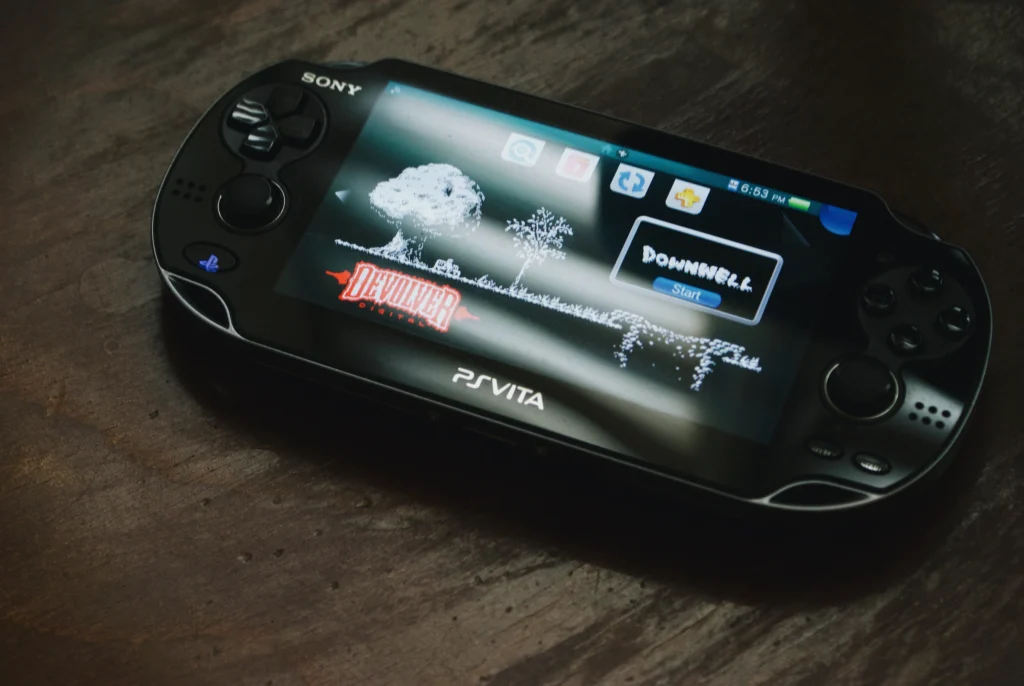
PlayStation Vita*
Core Specs & Info:
- Price: Depends on Used Market
- Screen Resolution: 960 x 544
- Screen Type and Size: 5-Inch OLED or LCD, depends on model
- Onboard Storage: 1 GB on some models, reliant on external storage otherwise
- Past System Compatibility: PSP, PS1, PS3/PS4 Remote Play; PS2 Through PS4 Remote Play
Pros:
- The last great Sony handheld, offering hardware performance comparable to the PS3 and dual-analog Remote Play to both PS3 and PS4 consoles.
- Screen looks superb with a very high PPI on either model, but is a particular standout on the OLED model.
- Effectively revives a number of PlayStation Portable games that were otherwise crippled by the lack of a second analog stick. You can now apply the second analog stick on the Vita to emulate the D-Pad of the PSP when playing games that used the D-Pad for camera controls, for example.
- Storefront is still active at the time of writing, like the Switch!
- Modding brings forth all the latent potential of the PSP, and more. PC game streaming,
Cons:
- Notoriously limited original game library, though many Vita games have a cult following to this day, like “Gravity Rush”.
- Also uses Sony’s expensive, proprietary “Memory Stick” storage.
The PlayStation Vita released in late 2011, in the same year as the original Nintendo 3DS. Considering it’s still more powerful than the late-gen “New” 3DS refresh that came out six years later, that’s pretty impressive! It even launched at the same price at $249, but didn’t see the same price reductions that the Nintendo 3DS saw over its life, most likely due to how expensive it was to produce to begin with.
Unfortunately for Sony, the DS’ runaway success kind of poised the 3DS for high momentum-on-launch. And Vita’s development support was pretty much gone two years in, though it did continue getting some indie releases and the occasional console port up to 2021, two years after it was officially discontinued by Sony.
It’s a shame that the Vita didn’t enjoy a longer time in the spotlight, but sometimes that’s just the nature of the highly-competitive handheld market, especially following the introduction of smartphones. It’s essentially the ultimate PlayStation handheld to an enthusiast, though, especially utilizing Remote Play. If you have an OLED model and a home with a PS3 and a PS4, you could make a good argument for playing some games on your Vita instead of a TV.
And finally…Vita had some pretty good games! PS Vita saw direct releases of Persona 3, 4, and 5, as well as a port of MGS2 and MGS3 HD from the PS3 HD collection. Indie titles were released regularly throughout the Vita’s lifetime as well, since the device was popular among enthusiasts and in crowdfunding campaigns as a stretch goal.
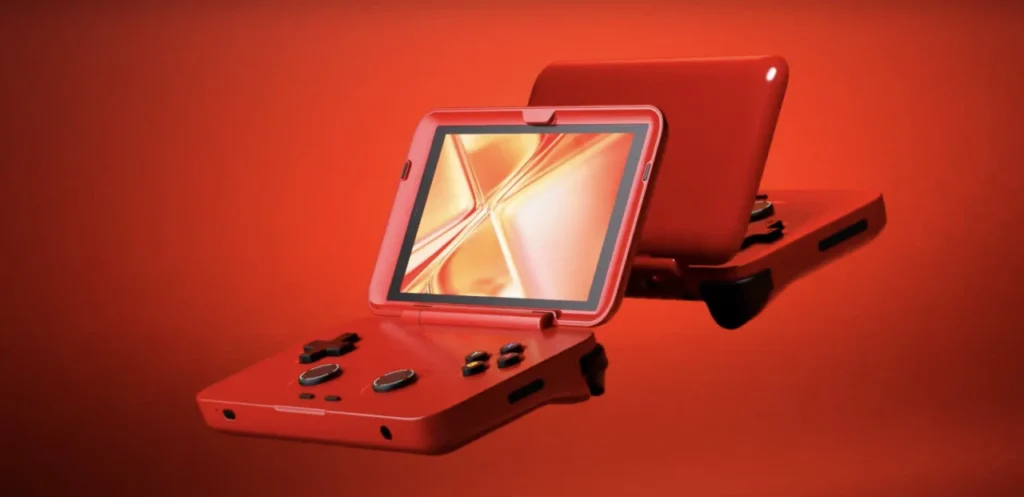
Retroid Pocket Flip
Core Specs & Info:
- Price: $164
- Screen Resolution: 750 x 1334
- Screen Type and Size: 4.7-Inch IPS
- Onboard Storage: 128 GB eMMC
- Past System Compatibility: Emulation Stable Up To PS1/N64 Home and PSP Portable Eras, newer systems and games are hit-or-miss
Pros:
- An emulation-centric Android handheld with a familiar clamshell design to the DS handhelds, but no actual dual screens. The buttons and dual analog nubs should feel familiar to anyone that’s used a 3DS, though.
- Competent emulation performance of home consoles up to the N64 and PS1. Portables up to the PSP are handled well, as well. Some GameCube and PS2 games may work, but for the most part the Retroid Pocket Flip and even its Pocket 3+ cousin start falling off hard in the GC/PS2 punching eras of emulation.
Cons:
- Clamshell design is not as sturdy as those on original DS/3DS handhelds, but remains considerably more portable than most other handhelds in its class.
The Retroid Pocket Flip is my pick for the best handheld console for retro gaming under $200, with a caveat. You’ll be relying solely on emulation and your own personal backups when using this device, since it doesn’t come with games of its own or even a cartridge slot for games.
I also don’t really have a history lesson to attach to this one…it’s just pretty nice for what it is. Runs Android and supports Wi-Fi and Bluetooth as well, so you’ll also be able to enjoy modern smartphone titles like…Fortnite on it. You’re here for retro, right? They put Marvel vs. Capcom 2 in that one, dude.
Class 2 — Collectors

Ayn Odin Pro
Core Specs & Info:
- Price: Starts at $287 For Base Model
- Screen Resolution: 1080 x 1920
- Screen Type and Size: 5.98-Inch IPS
- Onboard Storage: Comes in 128 GB or 256 GB eMMC
- Past System Compatibility: Emulation Machine Up To GameCube/PS2 Era Home and 3DS Era Handheld
Pros:
- As the emulation handheld enters a pricing range comparable to the non-Lite Switch, it actually pushes things to the next level and starts emulating GameCube and PS2 titles. While the Switch is also capable of GameCube emulation, this is a very difficult and pricey feature to come by on a smartphone or Android gaming handheld, and is locked behind closed doors on Switch.
- Besides being strong enough for emulating modern pre-Switch handhelds, the Odin Pro also comes in a slightly smaller form factor than the Switch, with more pronounced handles to boot.
- High-PPI display should ensure that even lower-res content still looks good.
Cons:
- Still a little expensive compared to the Switch Lite, but about as cheap as it gets for an emulation-focused handheld that can actually play GameCube and PS2 titles at full speed.
The Ayn Odin Pro is a recent launch, but it and its non-Pro predecessor stand out for being among the first “affordable” Android consoles that could emulate the GameCube and PS2 at high speeds. Prior to the Odin, an Android fast enough to run these emulators at full speed would typically need to be a flagship or mid-range Android smartphone rather than one of these Android consoles that get overshadowed by Deck and Laptops as you enter smartphone pricing territory.
In terms of pure hardware, I’d say the Ayn Odin Pro slides into a neat spot right between the Switch OLED and the Switch Lite.
The IPS display looks fairly nice, and is at a much higher pixel density and resolution than either of the already pixel-dense Switch consoles. However, the Switch OLED will look unquestionably better when displaying high-contrast or low-lighting scenes.
The size of the overall unit also falls “right between” Switch and Switch Lite, though the handles are more pronounced (for the better*) on the Odin Pro.
Unlike the Switch, though, you’ll be relying solely on the library of your own retro game backups or the Android Play Store on the Odin Pro. As long as you’re comfortable with that, though, the emulation performance on offer is easily comparable to the emulation performance of an unlocked Switch.
*Sidenote on handles on tablet-style handheld consoles: The Wii U Gamepad and Steam Deck both understand that big handles are better for longer gaming sessions, but the Switch corrects in the opposite direction with the Joy-Cons…probably due to the poor performance of the Wii U. Or just because.)
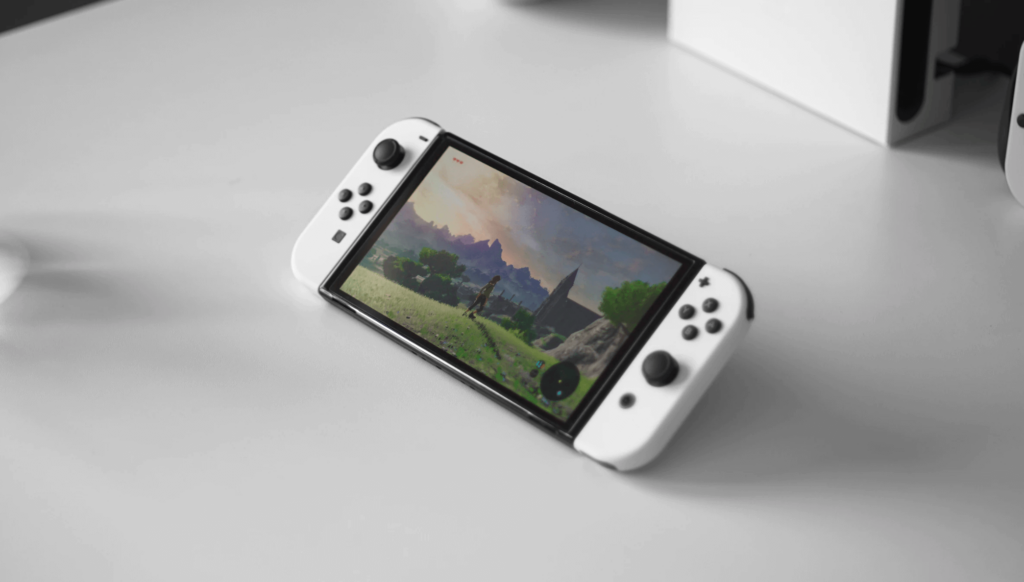
Nintendo Switch OLED
Core Specs & Info:
- Price: $349
- Screen Resolution: 1280 x 720
- Screen Type and Size: 7-Inch OLED
- Onboard Storage: 64 GB
- Past System Compatibility: Switch Online Membership (NES, SNES, Game Boy, N64*, Game Boy Advance*).
- Notes: *requires ‘Expansion Pack’ for additional fee
Pros:
- Small pricing advantage over Deck, and a gulf-like pricing advantage over most gaming laptops and gaming handhelds.
- OLED screen elevates the experience with the best color reproduction and contrast seen in a gaming handheld-to-its-release-date, but even the non-OLED Switch looked pretty good at this screen size.
Cons:
- Switch Online fees for retro catalog access, no option to just buy retro titles outside of full Switch re-releases.
- Like the Switch Lite, cannot emulate without hard-modding the system. Some older Switch models can be soft-modded in the right circumstances, or bought with soft mods, though.
The Nintendo Switch OLED is the latest revision of the Nintendo Switch, finally bringing an OLED display to Nintendo’s hybrid consoles. Unlike the Lite model, it does not come with a lower price point, smaller size, or compromise to docking functionality.
Considering the sales and the game porting and publishing happening on Switch, I’d say the OLED refresh was a good idea, and it’s been praised by quite a few outlets as the new killer feature of the full-size Switch experience. Of these outlets, I feel Digital Foundry’s review (embedded below) did the best job of explaining the benefits of the OLED Switch’s display:
Besides the addition of OLED, this really is just…the Nintendo Switch but slightly better. Definitely worth considering for a high-quality and low-headaches portable gaming experience, though.
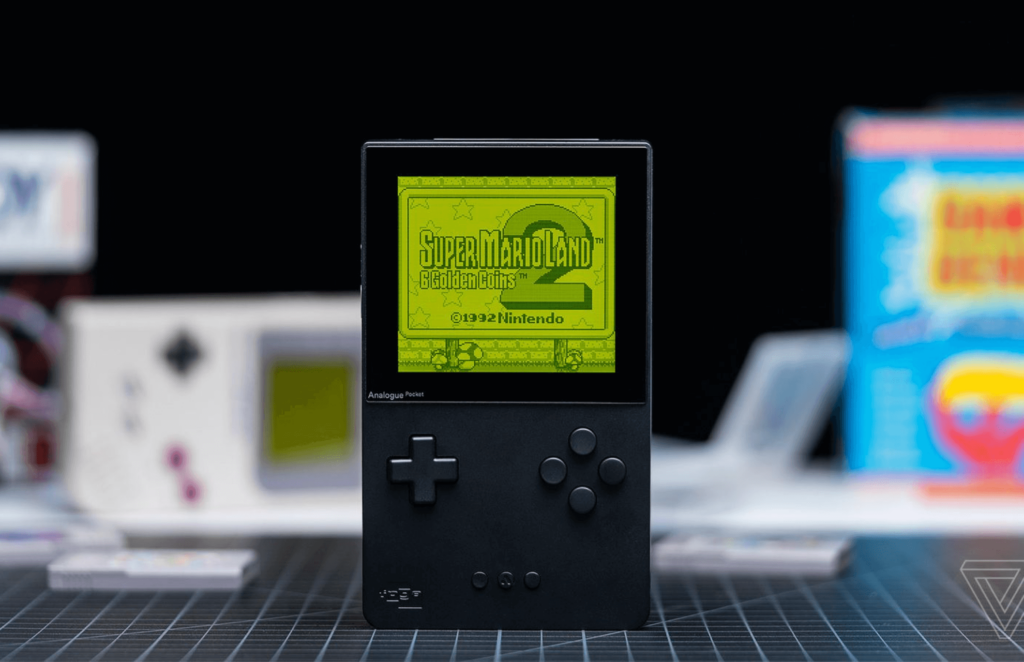
Analogue Pocket
Core Specs & Info:
- Price: $220
- Screen Resolution: 1600 x 1440
- Screen Type and Size: 3.5-Inch LTPS LCD
- Onboard Storage: N/A
- Past System Compatibility: Game Boy, Game Boy Color, Game Boy Advance without a slot adapter; Sega Game Gear, Neo Geo Pocket Color, TurboGrafx-16, and Atari Lynx with slot adapters
Pros:
- Form factor reminiscent of the original Game Boy design, but with added shoulder buttons for a more modern handling.
- Actually supports a wide variety of old cartridge-based handheld games, and isn’t even using emulation to do it. Physical media and FPGAs for the win!
- Gorgeous 1440p-quality screen in addition to 10x integer scaling enforcement on GB/GBC games results in truly stunning, hi-fi reproduction of the low-fi pixel art common to all generations of handheld console gaming.
Cons:
- Considerably expensive for the games you’ll be playing on it…but also the best way to play those games.
The Analogue Pocket is a premium handheld that breaks away from all the Android consoles by not relying on emulation to achieve its goals. Instead, it’s built in such a way that it completely reverse-engineers the functioning of several handheld consoles, and with an included cartridge slot to boot in order to use the original media!
Without adapters, this means compatibility with the entire Game Boy line of cartridges (Boy through Color to Advance), but adapters add other retro handheld cartridge games to the fray, too.
Besides being built in a unique way, the Analogue Pocket also offers a 1440p screen on a Game Boy-style form factor. In fact, the screen can provide a 10x integer scale on Game Boy and Game Boy Color games, making for the sharpest, clearest Game Boy screen conceivable.
While this screen isn’t OLED, it still manages to be the next best thing: LTPS. LTPS is a kind of LCD panel that also powers pixels on a per-pixel basis, but instead of improving darks and contrast like on OLED, LTPS LCD brings out sharper fidelity and color detail.
While I do think the Analogue Pocket has stellar potential as a collector’s item, especially once unlocked with community core support added (for even more retro 2D consoles, including SNES)…it’s still pretty expensive for what it is, compared to other options listed here.
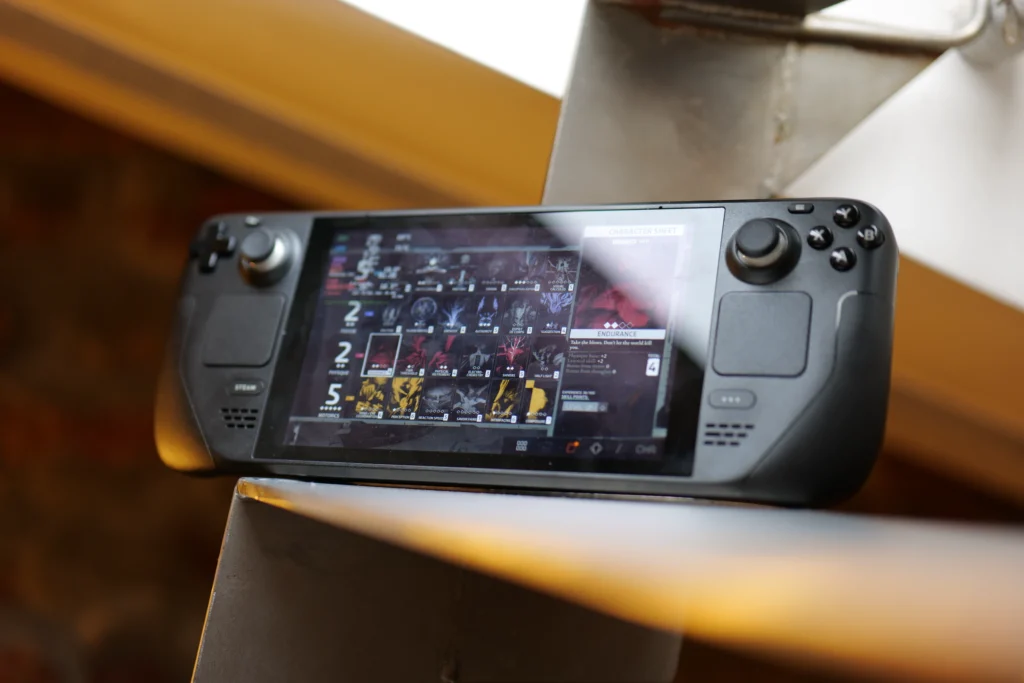
Steam Deck
Core Specs & Info:
- Price: Starts at $399 (Base Model)
- Screen Resolution: 1280 x 800
- Screen Type and Size: 7-Inch IPS
- Onboard Storage: Starts at 64 GB eMMC (Base Model)
- Past System Compatibility: Emulation Powerhouse Up To Ongoing PS3/360/Switch Emulation Development; Pretty Strong Support For Past Windows Titles Through Proton Compatibility on Linux
Pros:
- Probably the best handheld console for performance-per-dollar period, not just gaming, at least with the $399 model. Some competitors are beginning to compete against the higher-end models, but the $399 model targeted at the Switch absolutely demolishes it in sheer hardware power with a PS4-comparable level of strength in a handheld gaming PC.
- The heavy lead in performance offered by the Steam Deck and the open, Linux-based nature of its Steam OS also make it an ideal companion for emulation. The raw power for emulating the overwhelming majority of present-day consoles is present, and many emulators are developed on Linux. Or, at least, are compatible with the Vulkan or OpenGL backend usable on Linux.
- 800p IPS screen looks sharp and colorful, but even better with some in-OS tweaking.
- Can double as a proper desktop PC, unlike every other device on this list.
Cons:
- Minor, but it would be nice if there were an OLED Steam Deck option considering the Switch OLED and even the original PS Vita. Not having an OLED screen is really the only thing stopping Deck from being The gaming handheld, though.
Last but not least, there’s the Steam Deck! While I’ll actually be writing a separate article on how emulation is progressing for different platforms on Steam Deck, I can actually write a little ahead of that one for this one and let you know that the Steam Deck is unquestionably the best emulation machine on this list.
Besides experiences that are either truly tied to the hardware or best experienced on the hardware, like glasses-free 3D or seamless PlayStation 3/4 Remote Play, the Steam Deck’s hardware has very little competition for the price on the market. If you aren’t selling it cheaper or slapping an OLED on it, actually competing with the Deck in its niche of handheld gaming PCs is gonna be tough.
It isn’t all sunshine and rainbows on Steam Deck, though. While I could sing praises for the hardware power, software support, and comfort factor all day…the fact is, it’s still a handheld Linux PC. Steam OS Linux, sure, but still Linux. Any PC environment is going to have more variables and things to tweak and sort out than a walled-garden console environment like those on the Switch or the Vita.
So, while the Deck is pretty well-priced for what it is…I wouldn’t recommend it if you’re just wanting a straightforward gaming experience for the money. If you aren’t that tech-savvy, you’ll probably be better-suited with the Switch OLED.
Which Handheld Console Is Right For You?
Still not sure which handheld console suits your retro gaming needs after all that above? Let me break down my recommendations as quickly as possible:
- Switch OLED and Switch Lite Recommended For: Gamers looking for a no-headaches experience on a handheld that can still play modern games..
- PSP/PS Vita Recommended For: Gamers on a tighter budget who want to try the PlayStation side of handheld history and/or make the most of these powerful old handhelds through homebrew software and emulation.
- New 3DS Recommended For: Retro gamers who want to see the peak potential of Nintendo DS and 3DS games with glasses-free 3D intact. Even better, soft-modding also enables the emulation of Game Boy Advance, SNES, and N64 titles.
- Retroid Pocket 3/3+ Recommended For: Collectors on a budget who prefer the
PSP/Switch-style hardware design. - Retroid Pocket Flip Recommended For: Collectors on a budget or who simply prefer the folding clamshell design of classic handheld consoles.
- Analogue Pocket Recommended For: Collectors who want to use cartridges instead of backups, and see retro handheld games beyond their original peak forms without any emulation or modding required.
- Steam Deck Recommended For: Collectors or newcomers comfortable with PC gaming and tweaking. As long as you have some PC know-how, you can turn the Steam Deck into one of the best handheld consoles for retro gaming ever made, especially with many cutting-edge emulators having active Linux branches these days. Deck plays modern games pretty well, too.
Parting Words
And that’s it, at least for now!
I tackled all the best handheld consoles for retro gaming I could think of in this article, and I hope I helped point you in the direction of a handheld that will help you make the most of your on-the-go gaming. I also look forward to the coming days of more handheld gaming PCs competing with the Steam Deck in its pricing ranges, though I’ve yet to see any meaningful competition for the Deck at the entry-level $399 price point. What a bargain!
Anyway, enough of that for today. Feel free to leave a comment if you need any help picking a system, or want to put your weight behind any of the recommendations made in the article above. Until then or until next time you read our site, enjoy your games.

